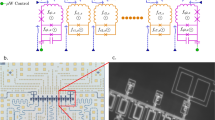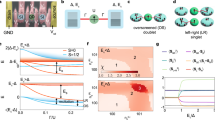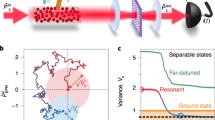Abstract
Entanglement is a concept that has defied common sense since the discovery of quantum mechanics. Two particles are said to be entangled when the quantum state of each particle cannot be described independently, no matter how far apart in space and time the two particles are. We demonstrate experimentally that unpaired spins separated by several hundred ångström entangle through a collection of spin singlets made up of antiferromagnetic spin-1/2 chains in a bulk material. Low-temperature magnetization and specific heat studies as a function of magnetic field reveal the occurrence of very dilute spin dimers and at least two quantum phase transitions related to the breaking of excited local triplets. The mechanism at the origin of the unpaired spins inside the quantum chains is the inter-modulation potential between two sublattices, and may be replicated using well-designed synthetic multilayers.
This is a preview of subscription content, access via your institution
Access options
Subscribe to this journal
Receive 12 print issues and online access
$209.00 per year
only $17.42 per issue
Buy this article
- Purchase on Springer Link
- Instant access to full article PDF
Prices may be subject to local taxes which are calculated during checkout





Similar content being viewed by others
References
Einstein, A., Podolsky, B. & Rosen, N. Can quantum-mechanical description of physical reality be considered complete? Phys. Rev. 47, 777–780 (1935).
Nielsen, M. A. & Chuang, I. L. Quantum Computation and Quantum Information (Cambridge Univ. Press, 2000).
Amico, L., Fazio, R., Osterloh, A. & Vedral, V. Entanglement in many-body systems. Rev. Mod. Phys. 80, 517–576 (2008).
Braunstein, S. L. & van Loock, P. Quantum information with continuous variables. Rev. Mod. Phys. 77, 513–577 (2005).
Bose, S. Quantum communication through an unmodulated spin chain. Phys. Rev. Lett. 91, 207901 (2003).
Bose, S. Quantum communication through spin chain dynamics: An introductory overview. Contemp. Phys. 48, 13–30 (2007).
Campos Venuti, L., Degli Esposti Boschi, C. & Roncaglia, M. Long-distance entanglement in spin systems. Phys. Rev. Lett. 96, 247206 (2006).
Campos Venuti, L., Degli Esposti Boschi, C. & Roncaglia, M. Qubit teleportation and transfer across antiferromagnetic spin chains. Phys. Rev. Lett. 99, 060401 (2007).
Sodano, P., Bayat, A. & Bose, S. Kondo cloud mediated long-range entanglement after local quench in a spin chain. Phys. Rev. B 81, 100412 (2010).
Bayat, A., Bose, S. & Sodano, P. Entanglement routers using macroscopic singlets. Phys. Rev. Lett. 105, 187204 (2010).
Vuletic, T. et al. The spin-ladder and spin-chain system (La, Y, Sr, Ca)14Cu24O41: Electronic phases, charge and spin dynamics. Phys. Rep. 428, 169–258 (2006).
Gellé, A. & Lepetit, M-B. Influence of the incommensurability in Sr14−xCaxCu24O41 family compounds. Phys. Rev. Lett. 92, 236402 (2004).
Matsuda, M., Yosihama, T., Kakurai, K. & Shirane, G. Quasi-two-dimensional hole ordering and dimerized state in the CuO2-chain layers in Sr14Cu24O41 . Phys. Rev. B 59, 1060–1067 (1999).
Regnault, L. P. et al. Spin dynamics in the magnetic chain arrays of Sr14Cu24O41: A neutron inelastic scattering investigation. Phys. Rev. B 59, 1055–1059 (1999).
Klingeler, R. et al. Magnetization of hole-doped CuO2 spin chains in Sr14−xCaxCu24O41 . Phys. Rev. B 72, 184406 (2005).
Fisher, Daniel S. Random antiferromagnetic quantum spin chains. Phys. Rev. B 50, 3799–3821 (1994).
Wiesniak, M., Vedral, V. & Brukner, C. Magnetic susceptibility as a macroscopic entanglement witness. New J. Phys. 7, 258 (2005).
Brukner, C., Vedral, V. & Zeilinger, A. Crucial role of quantum entanglement in bulk properties of solids. Phys. Rev. A 73, 012110 (2006).
Chakraborty, T., Singh, H., Singh, S., Gopal, R. K. & Mitra, C. Probing quantum discord in a Heisenberg dimer compound. J. Phys. Condens. Matter 25, 425601 (2013).
Chakraborty, T. et al. Experimental detection of thermal entanglement in a molecular chain. J. Appl. Phys. 114, 144904 (2013).
Das, D., Singh, H., Chakraborty, T., Gopal, R. K. & Mitra, C. Experimental detection of quantum information sharing and its quantification in quantum spin systems. New J. Phys. 15, 013047 (2013).
Wiesniak, M., Vedral, V. & Brukner, C. Heat capacity as an indicator of entanglement. Phys. Rev. B 78, 064108 (2008).
Singh, H. et al. Experimental quantification of entanglement through heat capacity. New J. Phys. 15, 113001 (2013).
Chakraborty, T., Singh, H. & Mitra, C. Signature of quantum entanglement in NH4CuPO4 ⋅ H2O. J. Appl. Phys. 115, 034909 (2014).
Arnesen, M. C., Bose, S. & Vedral, V. Natural thermal and magnetic entanglement in the 1D Heisenberg model. Phys. Rev. Lett. 87, 017901 (2001).
Osborne, Tobias J. & Nielsen, Michael A. Entanglement in a simple quantum phase transition. Phys. Rev. A 66, 032110 (2002).
Parmigiani, F. & Sangaletti, L. Behaviour of the Zhang–Rice singlet in CuGeO3, Bi2CuO4, and CuO. J. Electron. Spectrosc. Relat. Phenom. 107, 49–62 (2000).
Eccleston, R. S. et al. Spin dynamics of the spin-ladder dimer-chain material Sr14Cu24O41 . Phys. Rev. Lett. 81, 1702–1705 (1998).
Lorenzo, J. E. et al. Macroscopic quantum coherence of the spin triplet in the spin-ladder compound Sr14Cu24O41 . Phys. Rev. Lett. 105, 097202 (2010).
Jolicouer, Th. & Golinelli, O. Sigma-model study of Haldane-gap antiferromagnets. Phys. Rev. B 50, 9265–9273 (1994).
Johnston, D. C. et al. Thermodynamics of spin s = 1/2 antiferromagnetic uniform and alternating-exchange Heisenberg chains. Phys. Rev. B 61, 9558–9606 (2000).
Kataev, V. et al. Interplay of spin and charge dynamics in Sr14−xCaxCu24O41 . Phys. Rev. B 64, 104422 (2001).
Klingeler, R. et al. Magnetism of hole-doped CuO2 spin chains in Sr14Cu24O41: Experimental and numerical results. Phys. Rev. B 73, 014426 (2006).
Hase, M. 1/3 magnetization plateau observed in the s = 1/2 trimer chain compound Cu3(P2O6OH)2 . Phys. Rev. B 73, 104419 (2006).
Oshikawa, M., Yamanaka, M. & Affleck, I. Magnetization plateaus in spin chains: Haldane gap for half-integer spins. Phys. Rev. Lett. 78, 1984–1987 (1997).
Kageyama, H. et al. Exact dimer ground state and quantized magnetization plateaus in the two-dimensional spin system SrCu2(BO3)2 . Phys. Rev. Lett. 82, 3168–3171 (1999).
Shiramura, W. et al. Magnetization plateaus in NH4CuCl3 . J. Phys. Soc. Jpn 67, 1548–1551 (1998).
Ruegg, Ch. et al. Bose–Einstein condensation of the triplet states in the magnetic insulator TlCuCl3 . Nature 423, 62–65 (2003).
Jaime, M. et al. Magnetic-field-induced condensation of triplons in Han purple pigment. Phys. Rev. Lett. 93, 087203 (2004).
Sebastian, S. E. et al. Dimensional reduction at a quantum critical point. Nature 441, 617–620 (2006).
Modi, K., Brodutch, A., Cable, H., Paterek, T. & Vedral, V. The classical-quantum boundary for correlations: Discord and related measures. Rev. Mod. Phys. 84, 1655–1707 (2012).
Aldoshin, S. M., Fel’dman, E. B. & Yurishchev, M. A. Quantum entanglement and quantum discord in magnetoactive materials. Low Temp. Phys. 40, 1–16 (2014).
Henderson, L. & Vedral, V. Classical, quantum and total correlations. J. Phys. A 34, 6899–6905 (2001).
Ollivier, H. & Zurek, W. H. Quantum discord: A measure of the quantumness of correlations. Phys. Rev. Lett. 88, 017901 (2001).
Luo, S. Quantum discord for two-qubit systems. Phys. Rev. A 77, 042303 (2008).
Acknowledgements
We acknowledge the support of the European Community Research Infrastructures under the FP7 Capacities Specific Program, MICROKELVIN project number 228464.
Author information
Authors and Affiliations
Contributions
The idea was born out of discussion between J.E.L. and S.S. Samples came from V.S., C.M. and A.R. The magnetization experiment was carried out by C.P., the specific heat experiment was carried out by G.R. and S.S. and the inelastic-neutron-scattering experiment was carried out on the three-axis spectrometer IN12 at ILL, Grenoble, by J.E.L., L.P.R. and S.R. The data were analysed by S.S. and J.E.L. Finally J.E.L. wrote the manuscript with input from all the authors.
Corresponding authors
Ethics declarations
Competing interests
The authors declare no competing financial interests.
Supplementary information
Supplementary Information
Supplementary Information (PDF 1283 kb)
Rights and permissions
About this article
Cite this article
Sahling, S., Remenyi, G., Paulsen, C. et al. Experimental realization of long-distance entanglement between spins in antiferromagnetic quantum spin chains. Nature Phys 11, 255–260 (2015). https://doi.org/10.1038/nphys3186
Received:
Accepted:
Published:
Issue Date:
DOI: https://doi.org/10.1038/nphys3186
This article is cited by
-
Controllable dimensionality conversion between 1D and 2D CrCl3 magnetic nanostructures
Nature Communications (2023)
-
Long distance entanglement and high-dimensional quantum teleportation in the Fermi–Hubbard model
Scientific Reports (2023)
-
Method of constructing the entangled state of the particle system
Pramana (2023)
-
Crystal growth of quantum materials: a review of selective materials and techniques
Bulletin of Materials Science (2022)
-
Correlation-induced coherence and its use in detecting quantum phase transitions
Science China Physics, Mechanics & Astronomy (2022)



